VOLVO XC60 TWIN ENGINE 2019 Owners Manual
Manufacturer: VOLVO, Model Year: 2019, Model line: XC60 TWIN ENGINE, Model: VOLVO XC60 TWIN ENGINE 2019Pages: 695, PDF Size: 14.96 MB
Page 661 of 695
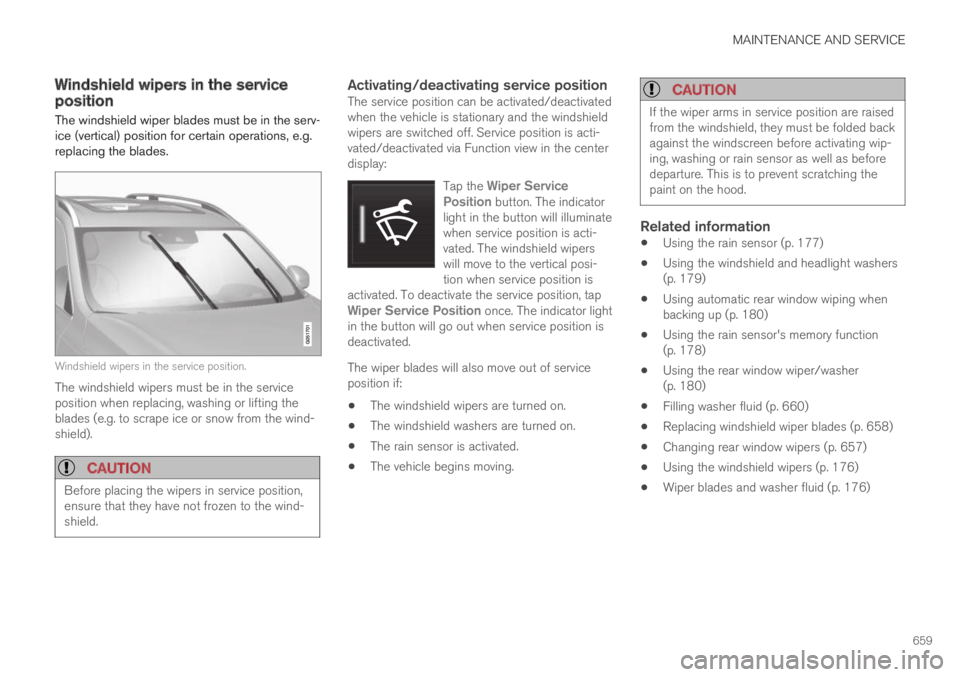
MAINTENANCE AND SERVICE
659
Windshield wipers in the serviceposition
The windshield wiper blades must be in the serv-ice (vertical) position for certain operations, e.g.replacing the blades.
Windshield wipers in the service position.
The windshield wipers must be in the serviceposition when replacing, washing or lifting theblades (e.g. to scrape ice or snow from the wind-shield).
CAUTION
Before placing the wipers in service position,ensure that they have not frozen to the wind-shield.
Activating/deactivating service position
The service position can be activated/deactivatedwhen the vehicle is stationary and the windshieldwipers are switched off. Service position is acti-vated/deactivated via Function view in the centerdisplay:
Tap the Wiper ServicePosition button. The indicatorlight in the button will illuminatewhen service position is acti-vated. The windshield wiperswill move to the vertical posi-tion when service position isactivated. To deactivate the service position, tapWiper Service Position once. The indicator lightin the button will go out when service position isdeactivated.
The wiper blades will also move out of serviceposition if:
The windshield wipers are turned on.
The windshield washers are turned on.
The rain sensor is activated.
The vehicle begins moving.
CAUTION
If the wiper arms in service position are raisedfrom the windshield, they must be folded backagainst the windscreen before activating wip-ing, washing or rain sensor as well as beforedeparture. This is to prevent scratching thepaint on the hood.
Related information
Using the rain sensor (p. 177)
Using the windshield and headlight washers(p. 179)
Using automatic rear window wiping whenbacking up (p. 180)
Using the rain sensor's memory function(p. 178)
Using the rear window wiper/washer(p. 180)
Filling washer fluid (p. 660)
Replacing windshield wiper blades (p. 658)
Changing rear window wipers (p. 657)
Using the windshield wipers (p. 176)
Wiper blades and washer fluid (p. 176)
Page 662 of 695
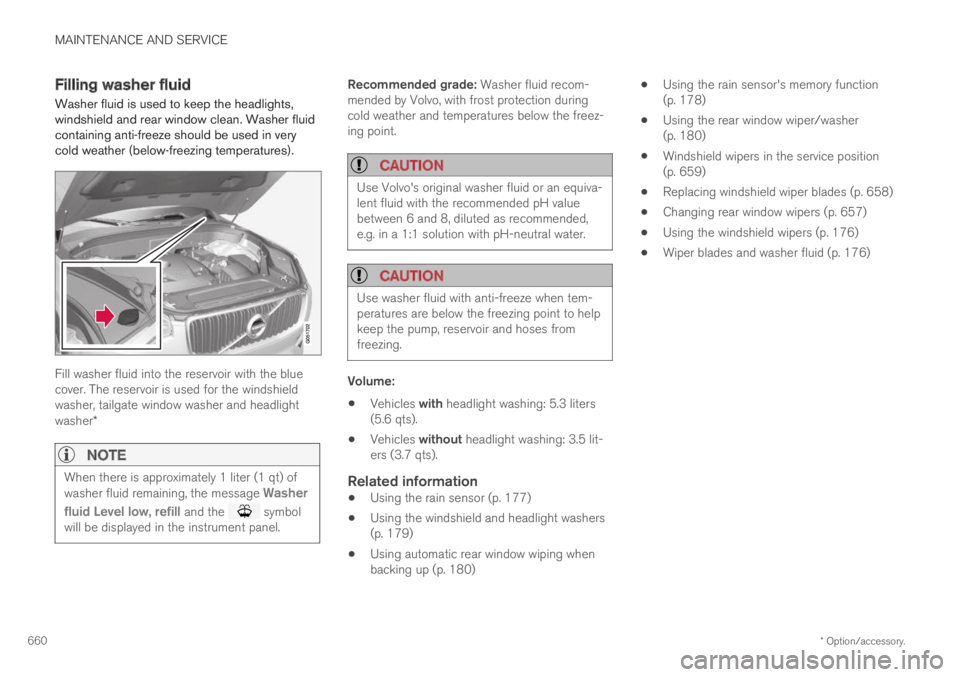
MAINTENANCE AND SERVICE
* Option/accessory.660
Filling washer fluid
Washer fluid is used to keep the headlights,windshield and rear window clean. Washer fluidcontaining anti-freeze should be used in verycold weather (below-freezing temperatures).
Fill washer fluid into the reservoir with the bluecover. The reservoir is used for the windshieldwasher, tailgate window washer and headlightwasher*
NOTE
When there is approximately 1 liter (1 qt) ofwasher fluid remaining, the message Washer
fluid Level low, refill and the symbolwill be displayed in the instrument panel.
Recommended grade: Washer fluid recom-mended by Volvo, with frost protection duringcold weather and temperatures below the freez-ing point.
CAUTION
Use Volvo's original washer fluid or an equiva-lent fluid with the recommended pH valuebetween 6 and 8, diluted as recommended,e.g. in a 1:1 solution with pH-neutral water.
CAUTION
Use washer fluid with anti-freeze when tem-peratures are below the freezing point to helpkeep the pump, reservoir and hoses fromfreezing.
Volume:
Vehicles with headlight washing: 5.3 liters(5.6 qts).
Vehicles without headlight washing: 3.5 lit-ers (3.7 qts).
Related information
Using the rain sensor (p. 177)
Using the windshield and headlight washers(p. 179)
Using automatic rear window wiping whenbacking up (p. 180)
Using the rain sensor's memory function(p. 178)
Using the rear window wiper/washer(p. 180)
Windshield wipers in the service position(p. 659)
Replacing windshield wiper blades (p. 658)
Changing rear window wipers (p. 657)
Using the windshield wipers (p. 176)
Wiper blades and washer fluid (p. 176)
Page 663 of 695
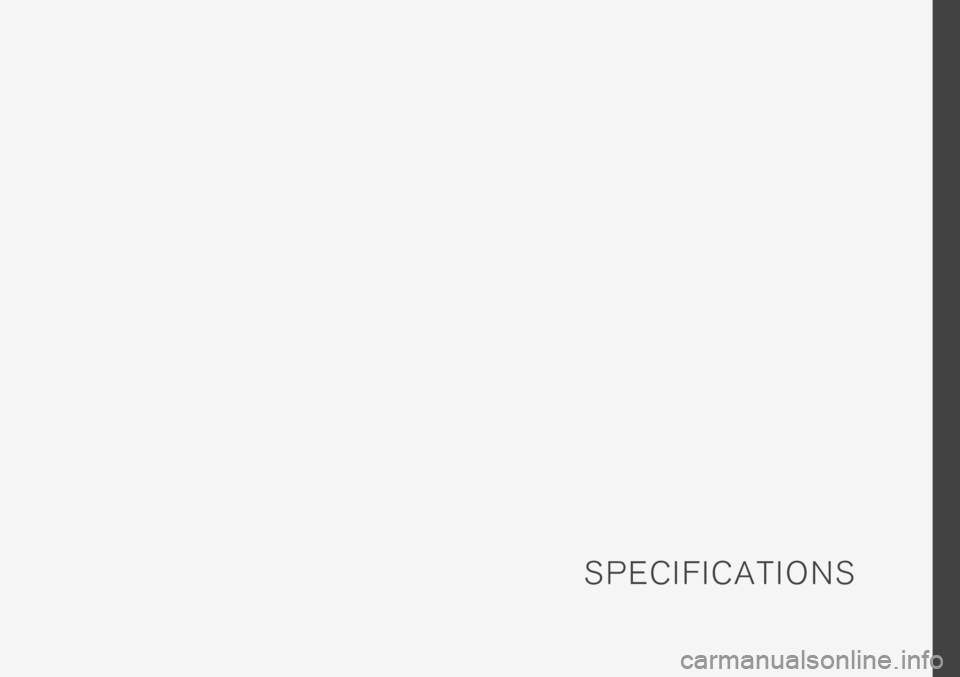
S P E C I F I C A T I O N S
Page 664 of 695
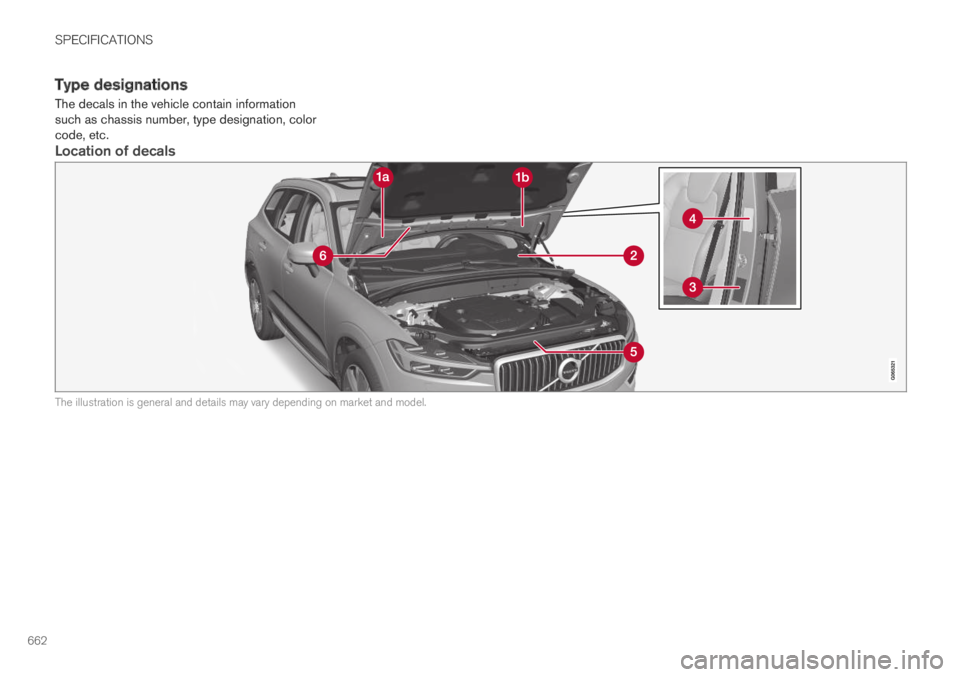
SPECIFICATIONS
662
Type designations
The decals in the vehicle contain informationsuch as chassis number, type designation, colorcode, etc.
Location of decals
The illustration is general and details may vary depending on market and model.
Page 665 of 695
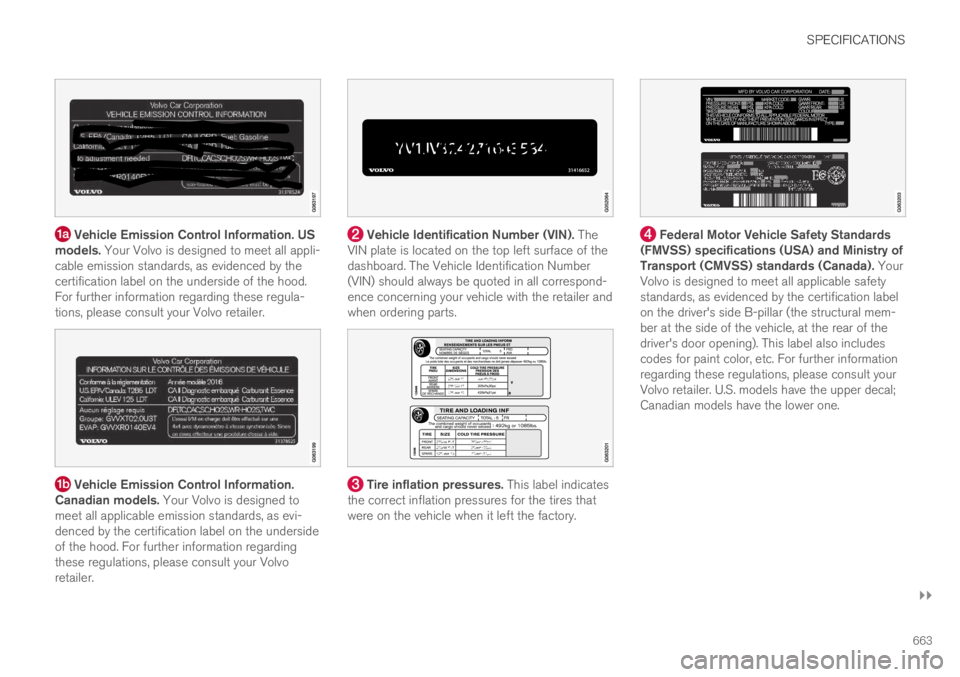
SPECIFICATIONS
}}
663
Vehicle Emission Control Information. USmodels. Your Volvo is designed to meet all appli-cable emission standards, as evidenced by thecertification label on the underside of the hood.For further information regarding these regula-tions, please consult your Volvo retailer.
Vehicle Emission Control Information.Canadian models. Your Volvo is designed tomeet all applicable emission standards, as evi-denced by the certification label on the undersideof the hood. For further information regardingthese regulations, please consult your Volvoretailer.
Vehicle Identification Number (VIN). TheVIN plate is located on the top left surface of thedashboard. The Vehicle Identification Number(VIN) should always be quoted in all correspond-ence concerning your vehicle with the retailer andwhen ordering parts.
Tire inflation pressures. This label indicatesthe correct inflation pressures for the tires thatwere on the vehicle when it left the factory.
Federal Motor Vehicle Safety Standards(FMVSS) specifications (USA) and Ministry ofTransport (CMVSS) standards (Canada). YourVolvo is designed to meet all applicable safetystandards, as evidenced by the certification labelon the driver's side B-pillar (the structural mem-ber at the side of the vehicle, at the rear of thedriver's door opening). This label also includescodes for paint color, etc. For further informationregarding these regulations, please consult yourVolvo retailer. U.S. models have the upper decal;Canadian models have the lower one.
Page 666 of 695
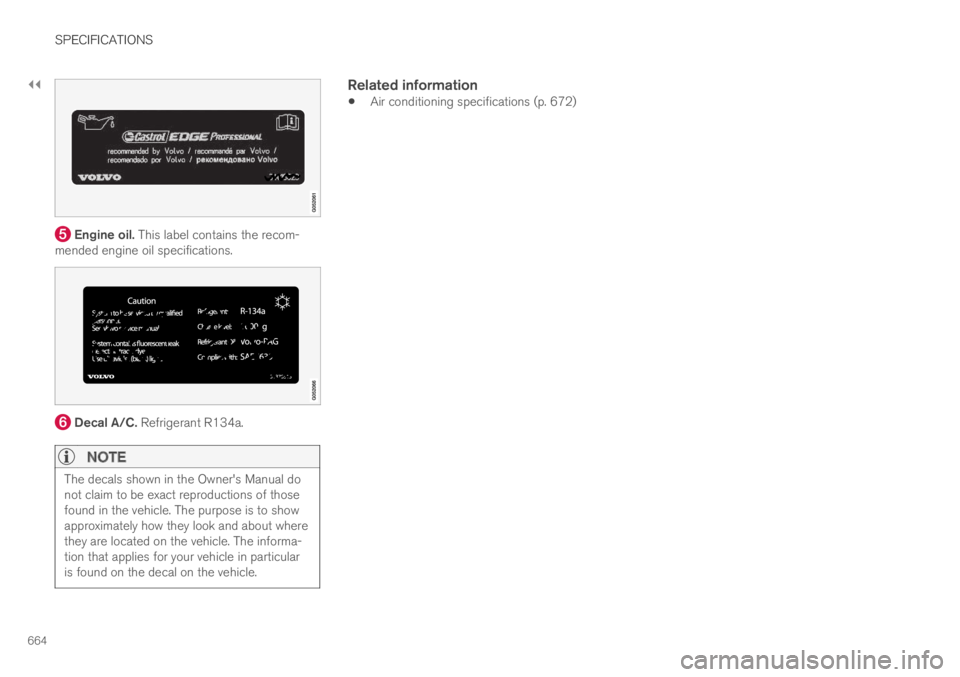
||
SPECIFICATIONS
664
Engine oil. This label contains the recom-mended engine oil specifications.
Decal A/C. Refrigerant R134a.
NOTE
The decals shown in the Owner's Manual donot claim to be exact reproductions of thosefound in the vehicle. The purpose is to showapproximately how they look and about wherethey are located on the vehicle. The informa-tion that applies for your vehicle in particularis found on the decal on the vehicle.
Related information
Air conditioning specifications (p. 672)
Page 667 of 695
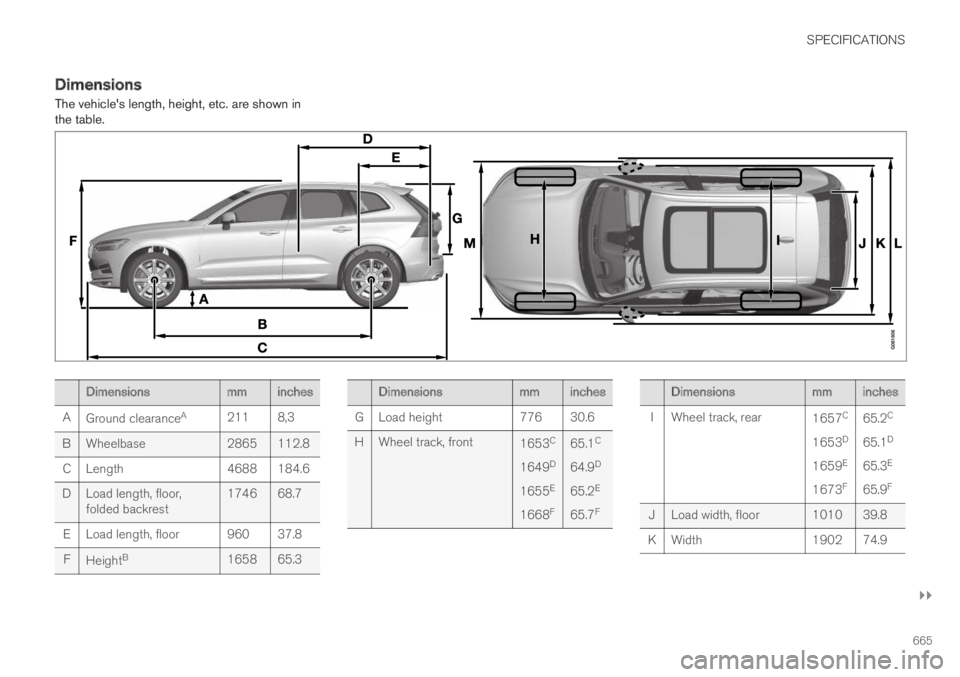
SPECIFICATIONS
}}
665
Dimensions
The vehicle's length, height, etc. are shown inthe table.
Dimensionsmminches
AGround clearanceA2118,3
B Wheelbase2865 112.8
C Length4688 184.6
D Load length, floor,folded backrest1746 68.7
E Load length, floor 960 37.8
FHeightB1658 65.3
Dimensionsmminches
GLoad height776 30.6
H Wheel track, front1653C
1649D
1655E
1668F
65.1C
64.9D
65.2E
65.7F
Dimensionsmminches
IWheel track, rear1657C
1653D
1659E
1673F
65.2C
65.1D
65.3E
65.9F
J Load width, floor 1010 39.8
K Width1902 74.9
Page 668 of 695
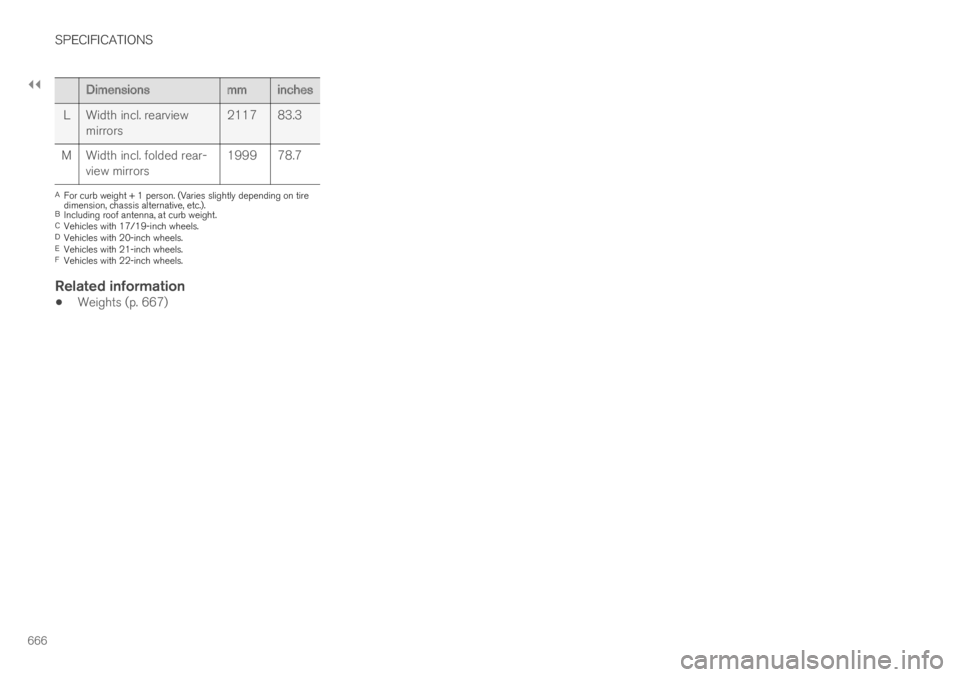
||
SPECIFICATIONS
666
Dimensionsmminches
LWidth incl. rearviewmirrors2117 83.3
M Width incl. folded rear-view mirrors1999 78.7
AFor curb weight + 1 person. (Varies slightly depending on tiredimension, chassis alternative, etc.).BIncluding roof antenna, at curb weight.CVehicles with 17/19-inch wheels.DVehicles with 20-inch wheels.EVehicles with 21-inch wheels.FVehicles with 22-inch wheels.
Related information
Weights (p. 667)
Page 669 of 695
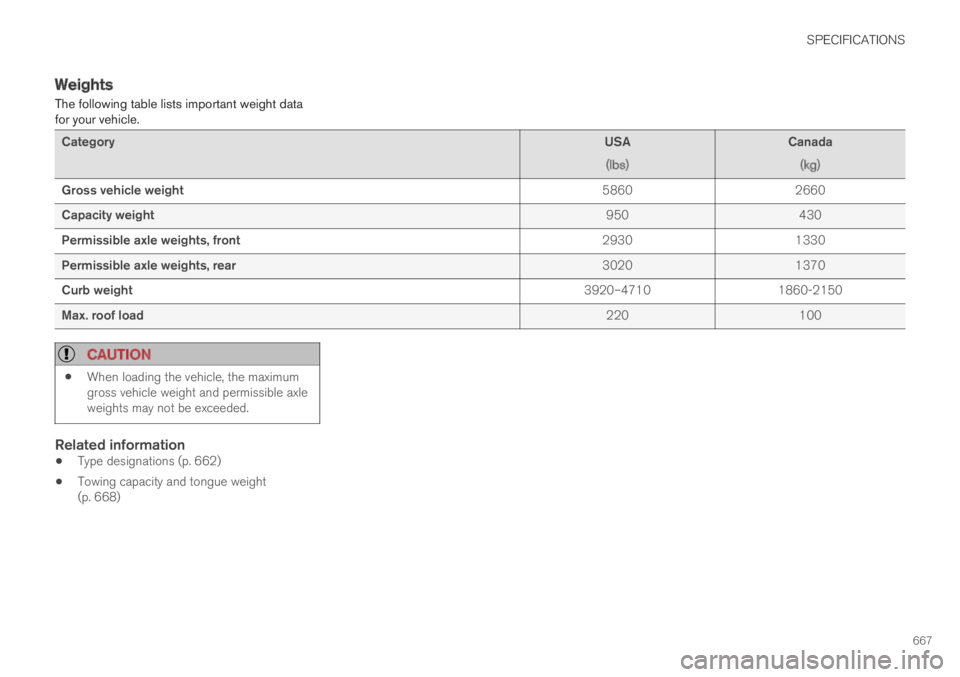
SPECIFICATIONS
667
Weights
The following table lists important weight datafor your vehicle.
CategoryUSA
(lbs)
Canada
(kg)
Gross vehicle weight58602660
Capacity weight950430
Permissible axle weights, front29301330
Permissible axle weights, rear30201370
Curb weight3920–47101860-2150
Max. roof load220100
CAUTION
When loading the vehicle, the maximumgross vehicle weight and permissible axleweights may not be exceeded.
Related information
Type designations (p. 662)
Towing capacity and tongue weight(p. 668)
Page 670 of 695
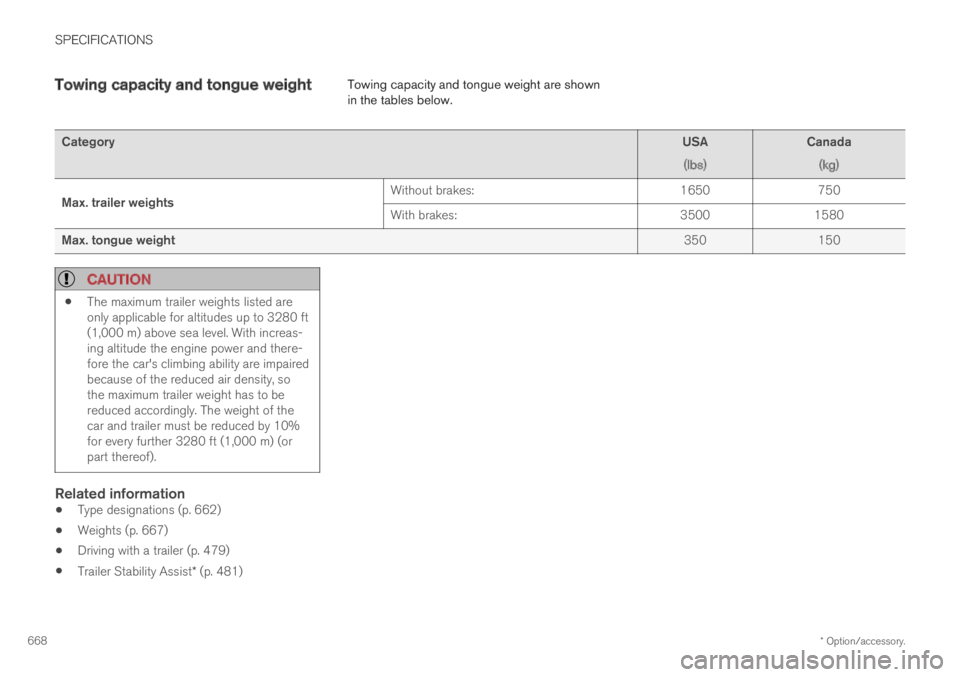
SPECIFICATIONS
* Option/accessory.668
Towing capacity and tongue weightTowing capacity and tongue weight are shownin the tables below.
CategoryUSA
(lbs)
Canada
(kg)
Max. trailer weightsWithout brakes:1650750
With brakes:35001580
Max. tongue weight350150
CAUTION
The maximum trailer weights listed areonly applicable for altitudes up to 3280 ft(1,000 m) above sea level. With increas-ing altitude the engine power and there-fore the car's climbing ability are impairedbecause of the reduced air density, sothe maximum trailer weight has to bereduced accordingly. The weight of thecar and trailer must be reduced by 10%for every further 3280 ft (1,000 m) (orpart thereof).
Related information
Type designations (p. 662)
Weights (p. 667)
Driving with a trailer (p. 479)
Trailer Stability Assist* (p. 481)